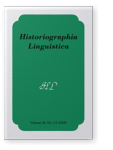Vol. 46:1/2 (2019) ► pp.88–104
Le tournant sémiotique du début du XXème siècle
Une approche sérielle
Le centenaire de la publication du Cours de linguistique générale (1916) de Ferdinand de Saussure nous a invité à reconsidérer l’importance de cet ouvrage et le rôle de son auteur pour la fondation d’une linguistique intégrée dans une sémiologie. Il n’y a aucun doute que cet auteur fut extrêmement important pour le développement de la linguistique structurale en Europe et qu’avec son concept du signe linguistique il a fait œuvre de pionnier pour le tournant sémiologique. Mais l’accueil favorable d’une théorie dans le milieu scientifique ne s’explique pas seulement par sa qualité intérieure, mais par plusieurs conditions extérieures. Ces conditions seront analysées sur trois plans: (1) l’arrivée de la méthode des néogrammairiens à ses limites qui incitait alors à l’étude de l’unité du signifiant et du signifié; (2) la simplification et l’outrance de la pensée structurale dans le Cours, publié en 1916 par Charles Bally et Albert Sechehaye et (3) la préparation de la réception de la pensée sémiologique par plusieurs travaux parallèles.
Article outline
- 1.Introduction
- 2.Textes de références et séries de textes
- 3. Les concepts ne naissent pas du néan: Une série préparatoire du Cours de linguistique générale
- 4.Les concepts se préparent implicitement: Une série de traités ‘sémiotiques’ avant Saussure
- 5.Conclusion
- Remarque
-
Références bibliographiques
Article language: French
